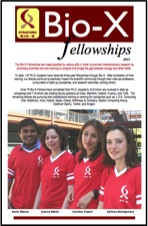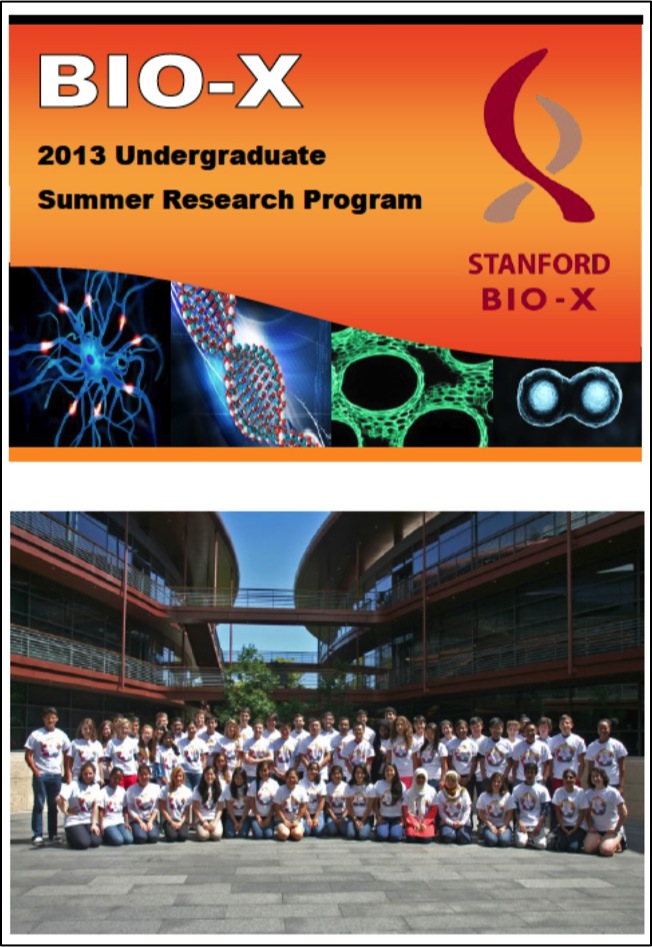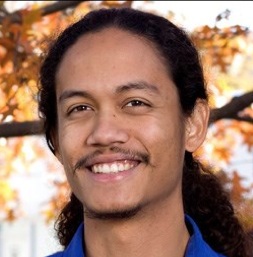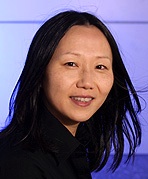
Welcome to the biweekly electronic newsletter from Stanford Bio-X for members of the Bio-X Corporate Forum. Please contact us if you would like to be added or removed from this distribution list, or if you have any questions about Stanford Bio-X or Stanford University.
Highlights
** On October 9, 2013, Bio-X celebrated the 10th Anniversary of the James H. Clark Center, the hub of Bio-X. Check out CLARK CENTER @ 10X on the SPLASH PAGE as well as the Bio-X Timeline over the last 15 years!!
** Check out the article by Stanford President John Hennessy in the Nov/Dec 2013 issue of the Stanford Magazine on Bio-X and the Clark Center, "A Cauldron of Innovation".
Seed Grants
 SEED GRANTS FOR SUCCESS - Stanford Bio-X Interdisciplinary Initiatives Program (IIP)
SEED GRANTS FOR SUCCESS - Stanford Bio-X Interdisciplinary Initiatives Program (IIP)
The Bio-X Interdisciplinary Initiatives Program represents a key Stanford Initiative to address challenges in human health. The IIP awards approximately $3 million every other year in the form of two-year grants averaging about $150,000 each. From its inception in 2000 through the fifth round in 2010, the program has provided critical early-stage funding to 114 different interdisciplinary projects, involving collaborations from over 300 faculty members, and creating over 450 teams from five different Stanford schools. From just the first 5 rounds, the IIP awards have resulted in a 10-fold-plus return on investment, as well as hundreds of publications, dozens of patents filed, and most importantly, the acceleration of scientific discovery and innovation.
In 2012, Stanford Bio-X selected 23 new seed grant projects as the winners of the 6th round. Please go here to view the list of awardees, along with the titles of their projects and the abstracts of the research. Competition was intense as the awardees were chosen from 118 Letters of Intent (LOIs). Selection criteria included innovation, high-reward, and interdisciplinary collaboration. (To view the 114 other IIP projects that have been funded from the first 5 rounds, please click here.) In addition, SANOFI has also funded 4 new Bio-X IIP Seed Grant projects from round 6!
On Monday, August 26, 2013, Bio-X had its second annual IIP Symposium of the year at the Clark Center, which highlights projects that exemplify the Stanford Bio-X mission of crossing boundaries to bring about interdisciplinary research and solutions in the field of life bioscience. The symposium was a huge success with over 300 people attending this event, which included 8 oral presentations and 136 poster presentations. Recorded talks from the symposium will be uploaded soon. If you'd like to view the talks for previous symposia through the years, please click here.
We are cultivating and are highly successful in building meaningful collaborations with numerous corporate colleagues. New collaborations through our seed grant projects are highly encouraged. To learn about how to get involved, please contact Dr. Hanwei Li or Dr. Heideh Fattaey.
Fellowships
 BIO-X FELLOWSHIPS
BIO-X FELLOWSHIPS
** Bio-X just announced its call for applications for its 11th year of Bio-X Graduate Student Fellowships.
Every year, graduate students and postdoctoral scholars of Bio-X affiliated faculty are highly encouraged to apply for the Bio-X Fellowships, which are awarded to research projects that are interdisciplinary and utilize the technologies of different fields to solve different biological questions. Students are encouraged to work collaboratively with professors of different departments, thus creating cross-disciplinary relationships among the different Stanford schools. Our fellows have conducted exciting research, resulting in publications in high-impact journals and have been offered excellent positions in industry and academia. To date, Stanford Bio-X has a total of 152 Fellows.
On June 26, 2013, Bio-X held its annual Bio-X Fellows Symposium, where there were four 15-minute oral presentations followed by one-minute spiels from current fellows. The 25 newest fellows selected this year were also announced, and about 100 attendees came to the symposium. Please click on the "Bio-X Fellows Symposium" link above for the agenda and titles of the talks, and on the icon of the brochure above for the updated and latest Bio-X Fellowships brochure.
To view the numerous projects that have been awarded over the years, please click here.
 BIO-X UNDERGRADUATE SUMMER RESEARCH PROGRAM
BIO-X UNDERGRADUATE SUMMER RESEARCH PROGRAM
The Bio-X Undergraduate Summer Research Program supports undergraduate research training through an award designed to support interdisciplinary undergraduate summer research projects. The program is an invaluable opportunity for students to conduct hands-on research, learn how to carry out experiments in the laboratory, and develop the skills to read and analyze scientific literature.
This program is eligible to Stanford students who want to work in the labs of Bio-X affiliated faculty. To date, 241 students have been awarded the opportunity to participate in the Bio-X Undergraduate Summer Research Program. This summer is Stanford Bio-X's 8th round of USRP.
Participating undergraduates are also required to present poster presentations on the research that they've conducted during the program. Please click here for title lists of past posters that our undergraduates have presented.
Many fruitful collaborations and relationships have been established with industry through fellowships. Please contact Dr. Hanwei Li or Dr. Heideh Fattaey if you'd like to learn more about how to get involved with these fellowship programs.
News
 Solving big problems with tiny prototypes
Solving big problems with tiny prototypes
Bio-X Fellow Joel Sadler in Prof. Sakti Srivastava's lab
Joel Sadler is a BioX Fellow at Stanford University, where he explores enhancing human creativity with better prototyping tools. While studying engineering at the Massachusetts Institute of Technology, he became interested in the needs of wheelchair users and developed a love of the design process applied to the human body. In this inspiring TEDx Jamaica talk (please access the talk through the link to the article) Joel Saddler describes how he, as part of a team, designed the JaipurKnee prosthetic, an affordable knee joint for amputees that has impacted thousands of lives. Joel's work on the JaipurKnee has received worldwide recognition, including being honored by Time Magazine as one of the top 50 inventions of 2009.
 Stanford bioengineers redesign protein motors to create novel nanomachines
Stanford bioengineers redesign protein motors to create novel nanomachines
Bio-X Affiliated Faculty Zev Bryant
Inside our cells, proteins known as myosins can act as a delivery service for biological materials. To better understand how molecular motors move, Stanford bioengineers have built experimental versions of the proteins, changing the way these transporters get around. Led by Zev Bryant, an assistant professor of bioengineering at Stanford, a team of researchers has genetically engineered “mutant” myosins with new features such as gearshifts and improved traction. The group’s most recent findings are published in the January issue of Nature Nanotechnology, where they are highlighted alongside other studies of molecular motors. “You look at biology, and you see motors that have diverse mechanical properties, and you want to understand how these arise,” Bryant said. “You test your understanding by trying to build something new.” Molecular motors are a class of proteins that make up the moving machinery of cells. Myosins are one family of molecular motors. Some of them can shuttle biomolecules from one region of the cell to another. These myosins move along microscopic filaments made of the protein known as actin. These actin filaments are one component of the cytoskeleton, or internal support structure of the cell. Bryant wanted to test his understanding of how evolution has designed these myosin proteins to shuttle cellular freight. Funded by an NIH “New Innovator” Award, members of the group launched a series of experiments in 2008 that steered their myosin research in a new direction.
 Engineers make world's fastest organic transistor, heralding new generation of see-through electronics
Engineers make world's fastest organic transistor, heralding new generation of see-through electronics
Bio-X Affiliated Faculty Zhenan Bao
Two university research teams have worked together to produce the world’s fastest thin-film organic transistors, proving that this experimental technology has the potential to achieve the performance needed for high-resolution television screens and similar electronic devices. For years engineers the world over have been trying to use inexpensive, carbon-rich molecules and plastics to create organic semiconductors capable of performing electronic operations at something approaching the speed of costlier technologies based on silicon. The term “organic” was originally confined to compounds produced by living organisms but now extended to include synthetic substances based on carbons and includes plastics. In the Jan. 8 edition of Nature Communications, engineers from the University of Nebraska-Lincoln (UNL) and Stanford University show how they created thin-film organic transistors that could operate more than five times faster than previous examples of this experimental technology. Research teams led by Zhenan Bao, professor of chemical engineering at Stanford, and Jinsong Huang, assistant professor of mechanical and materials engineering at UNL used their new process to make organic thin-film transistors with electronic characteristics comparable to those found in expensive, curved-screen television displays based on a form of silicon technology.
Events
| Genetics January 22, 2014, 4 pm - 5 pm Clark Center Auditorium, Stanford, CA FRONTIERS IN BIOLOGY - "Unraveling the code of gene regulation using thousands of designed regulatory sequences" Speaker: Eran Segal, Weizmann Institute |
Neurosciences Institute January 23, 2014, 12 pm - 1 pm Clark Center Auditorium, Stanford, CA "Signaling pathways that instruct rapid changes in neuronal connectivity" Speaker: Suzanne Paradis, Brandeis University |
| Neurology & Neurosciences January 27, 2014, 1 pm - 4 pm Clark Center Auditorium, Stanford, CA FRONTIERS IN AGING - Paul F. Glenn Laboratories Symposium Speakers: Elizabeth Blackburn, PhD, UCSF, David Sinclair, PhD, Harvard Medical School, Steven Austad, PhD, UT Health Science Center |
Neurosciences Institute January 29, 2014, 12 pm - 1 pm Munzer Auditorium, Stanford, CA "Innate instruction of antiviral immunity" Speaker: Akiko Iwasaki, Yale University |
Resources
| Stanford University |
| Stanford Bio-X |
| Bio-X Seed Grants The Stanford Bio-X Interdisciplinary Initiatives Program (IIP) provides seed funding for high-risk, high-reward, collaborative projects across the university, and have been highly successful in fostering transformative research. |
| Office of Technology and Licensing "Techfinder" Search the OTL Technology Portal to find technologies available for licensing from Stanford. |
| Stanford Center for Professional Development - Take advantage of your FREE membership! - Take online graduate courses in engineering, leadership and management, bioscience, and more. - Register for free webinars and seminars, and gets discounts on courses. |
| Stanford Biodesign Video Tutorials on how FDA approves medical devices A series of video briefs recently produced by the Stanford Biodesign Program teaches innovators how to get a medical device approved for use in the United States. This free, online library of 60 videos provides detailed information on the Food and Drug Administration regulatory process, short case studies and advice on interacting with the FDA. |
To learn more about Stanford Bio-X or Stanford University, please contact Dr. Hanwei Li, the Bio-X Corporate Forum Liaison, at 650-725-1523 or lhanwei1@stanford.edu, or Dr. Heideh Fattaey, the Executive Director of Bio-X Operations and Programs, at 650-799-1608 or hfattaey@stanford.edu.

